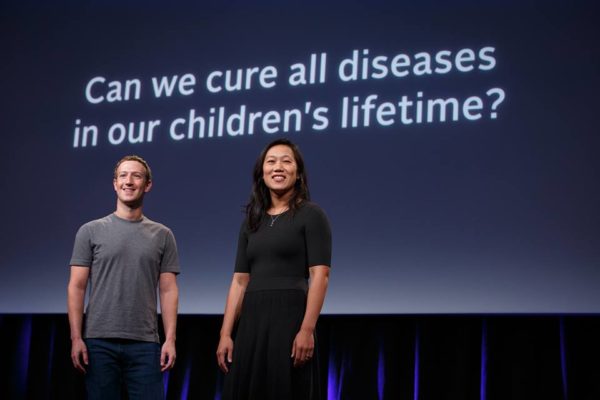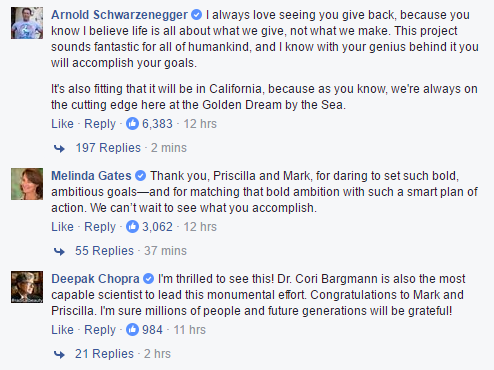“Can we help scientists to cure, prevent or manage all diseases within our children’s lifetime? I’m optimistic we can,” Mark Zuckerberg, Founder & CEO ofFacebook said, in an announcement by the Chan Zuckerberg Initiative on Wednesday.
Zuckerberg and his wife, Priscilla Chan went live on Facebook to announce it’s next initiative, which is to have a cure for all diseases by the end of the Century.
Read what Zuckerberg wrote on Facebook:
When our daughter was born, we wrote a letter about the hope she gave us for the future. It’s a hope I know so many of us feel – that we can make a better future for our children and generations to come. I’m an engineer, and I think this hope is part of the engineering mindset.It’s the belief that you can take any system and make it much better – whether it’s code, hardware, biology, a company, an education system, a government – anything. We look for ways to bring engineering to social change. That’s what we’ve done at Facebook to build a community of more than 1.7 billion people. That’s what we’ve done with Internet.org to help local entrepreneurs connect more than 30 million people to the internet. That’s what we’re doing with personalized learning to help teachers bring these tools to more than 100 schools. And that’s how we hope to help scientists as well.Priscilla and I have spent the last few years talking to dozens of top scientists and experts who believe it’s possible to cure, prevent or manage all diseases by the end of this century. That doesn’t mean no one will ever get sick, but it does that mean that we’ll get sick a lot less, and that when we do, we’ll always be able to identify and treat the problem, or at least manage it as a non-harmful condition.Medicine has only been a modern science for about a century, and we’ve already made incredible progress. Think about that. For thousands of years, we made very little progress. Then we started applying the scientific method to investigating diseases and progress really took off.Since then we’ve eradicated smallpox and are close to eradicating polio. We can prevent meningitis, measles and many forms of influenza with vaccines. We discovered antibiotics to treat potentially deadly infections like tuberculosis and pneumonia. We produced insulin to manage diabetes, statins to reduce heart disease, and chemotherapies to treat cancer. We’ve reduced smoking through public education. We’ve even found ways to reduce life-threatening diseases like HIV to conditions we can manage.Over the last century, life expectancy has increased by 1/4 year each year, driven by advances in science and public health. If this trend only continues, then at the end of the century our *average* life expectancy will be around 100. This trend implies we will have cured the diseases that prevent most people from reaching that age today. As technology accelerates, I’m optimistic we can do even better.Today, most people die from four kinds of diseases: heart disease (10.8 million, 19.2%), cancer (8.2 million, 14.6%), infectious disease (8.5 million, 15.1%) and neurological disease like stroke (6.8 million, 12.1%). Of the rest, almost half are due to accidents and injuries (5.8 million, 10.3%) or otherwise unrelated to disease (3.1 million, 5.5%).This gives us an idea of where to focus to start. I don’t want to oversimplify the problem. Each category has many different conditions and areas to study. For example, every cancer is a different disease. It is unlikely each category can be addresses by a single breakthrough. But for each category, there are common strategies for addressing those diseases and common tools and technology we can develop to better understand and fight them more effectively.Throughout the history of science, most scientific breakthroughs have been preceded by the invention of new tools that help us see and experiment in new ways. The telescope let us see the planets and stars, which enabled us to learn about astronomy and the universe. The microscope let us see cells and bacteria, which enabled us to identify and treat diseases like malaria and pneumonia. DNA sequencing and now editing lets us understand our genomes to help us precisely fight cancers and genetic disorders.Tools also create breakthroughs in how we treat diseases. Vaccines are a broadly applicable tool that we can now reuse and build upon to prevent more and more diseases. It’s easy to imagine modern tools that could unlock progress in each of the four major disease categories today: AI (Artificial Intelligence) software to interpret brain imaging or datasets of cancer genomes, a chip to diagnose any infectious disease, continuous bloodstream monitoring to identify diseases early, and maps of all the different cell types and states to help design drugs to combat any given disease.Focusing on tools suggests a roadmap to help cure, prevent and manage all diseases. If we can help develop new tools to see each of the major disease categories in new ways, then we can enable scientists around the world to make breakthroughs in those diseases faster. Building tools will require new ways of organizing and funding science. Most science funding today is small grants less than a few hundred thousands of dollars. This may help pay for scientists’ salaries or part of a lab, but it’s not enough to do major tool development. Tool development often requires groups of scientists and engineers working together over long periods of time.For example, the internal combustion engine was developed by scientists and engineers over decades. Eventually, this tool unlocked many inventions, including cars and aircraft. But it took a big investment, large scale collaboration and a long time horizon. That brings us to our plan. We’re going to focus on bringing scientists and engineers together to build new tools that can empower the whole scientific community to make breakthroughs on the four major disease categories. Solving large problems requires finding new ways for scientists and engineers to work together, share data and coordinate. Most science funding today goes towards individuals working separately, so there is an open opportunity to fund larger efforts.Engineering has always been key to tool development. Today, this increasingly means software engineering. But the current structure of scientific grants does not encourage big scientific efforts with world-class engineers teams, like the ones you’d find at great technology companies. This is required for developing many modern tools, so this will be our focus. We will also push for more science funding.Today, our society spends 50 times more treating people who are sick than we invest in finding cures so people don’t get sick in the first place. You’d only invest this way if you believed people would always suffer from disease. In that case, you’d do the best you could treating people and hope science improves health at the margin. That’s what investing 50 times more in treating people than in curing disease looks like. But in a world where we can actually cure all disease in our children’s lifetime, we should invest dramatically more in this opportunity.There are many opportunities for governments, non-profits and companies to invest more in curing diseases, and in developing tools to empower the whole scientific community. This is an area where public support matters. The more people believe we can cure all disease in our children’s lifetimes, the more likely the government is to invest in it, and the more likely we are to achieve this goal. This is a place where we need your help, and we can all make a difference together.After years of learning about these problems, talking to top scientists and experts, reading everything we could get our hands on, and getting into the math of how science is funded, we are optimistic that it is possible to cure, prevent or manage all disease in our children’s lifetime. If we can bring scientists and engineers together to build the right tools, then we can accelerate breakthroughs on the major diseases, and we can continue until there are no more left.Remember, this is a long term effort. We plan to invest billions of dollars over decades. It will take years for the first tools to be developed, and then years after that before they are used to cure diseases. This is hard and we need to be patient, but it’s important. This is about the future we want for our daughter and children everywhere. If there’s a chance that we can help cure all diseases in our children’s lifetimes, then we will do our part. Together, we all have a real shot at leaving the world a better place for our children than we found it.
In a Facebook post earlier, Zuckerberg shared a few steps the Initiative is taking to achieve the goal:
Dr. Cori Bargmann, a world-renowned expert in neuroscience and genetics, is joining the Chan Zuckerberg Initiative to lead this initiative. We are thrilled to welcome her.We are committing to invest $3 billion over the next decade in this initiative to help scientists cure diseases.Our first project is creating the Biohub. We’re investing $600 million in a new research hub to bring scientists and engineers together from Stanford, UCSF, Berkeley, and the world-class engineering team we’re building at the Chan Zuckerberg Initiative, in order to build some of the new tools I mentioned above.The science initiative is a long term effort. We plan to invest billions of dollars over decades. But it will take years for these tools to be developed and longer to put them into full use. This is hard and we need to be patient, but it’s important.This is about the future we want for our daughter and children everywhere. If there’s a chance that we can help cure all diseases in our children’s lifetime, then we will do our part. Together, we have a real shot at leaving the world a better place for our children than we found it.
Veteran actor and former governor of California, Arnold Schwarzenegger,Melinda Gates, and renowned author, Deepak Chopra commended the ambitious goal.


No comments:
Post a Comment